Transitional South Minneapolis Kitchen Remodel
Revisiting a Remodel: A new kitchen brought this family even closer
For this Minneapolis couple, the investment in a remodel was all about their daughter. And it’s paying off big time.
Kate and her wife, Anne, had considered a remodel on their tiny South Minneapolis home for years, but it took some convincing for Kate to see the value.
“We have a very small house,” she says, “so part of me thought, you know, there’s only a certain amount of money we’ll get out of an update.” She wasn’t sure it was worth the investment.
Then Anne said something that changed her perspective entirely.
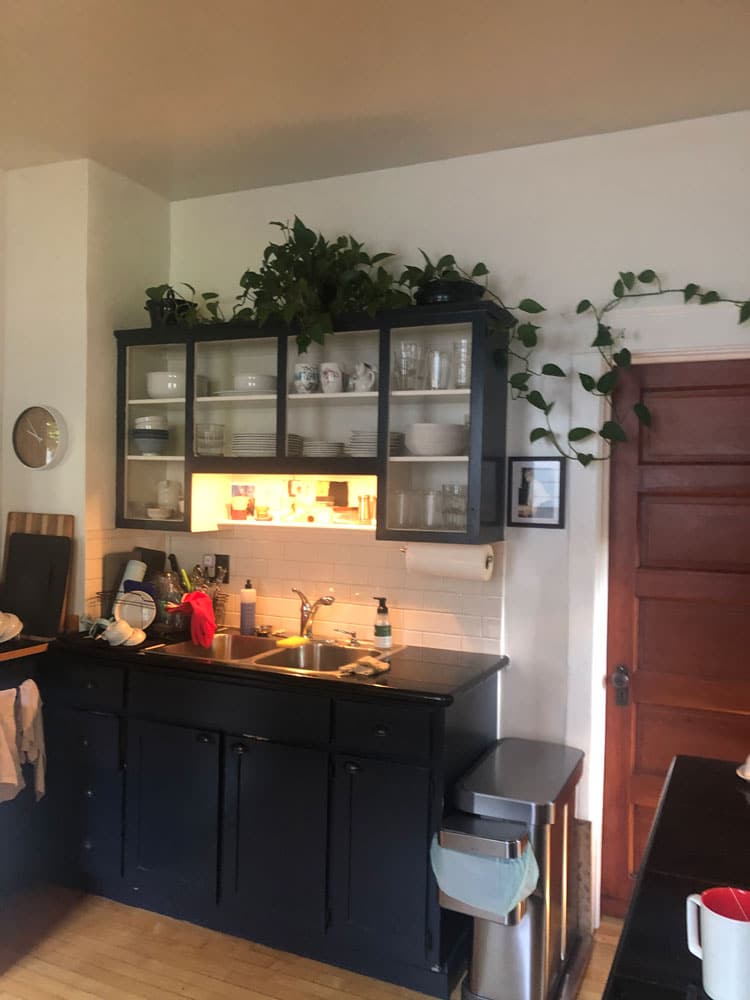
“You never get this time back.”
The couple’s tiny, segmented home was making it challenging to spend the kind of time they wanted with their nine-year-old. “Our daughter loves to do arts,” says Kate, “and she would do that in the dining room. I could see her through the doorway of the kitchen, but I couldn’t do anything with her, or be with her.”
It was frustrating.
Both parents wished they had larger rooms where they could all be together at once, but they didn’t want to move. They loved their neighborhood. They loved the nearby park. And they loved the hundred-year-old oak trees that made their little lot a private oasis.
Still, Kate wasn’t sure a remodel was worth the investment. Then, one day, Anne, who had two grown children of her own, said something that stuck. “You never get this time back with your kids,” she said. “It’s this precious time.”
“That really did it for me,” says Kate. “It felt like it wasn’t just a monetary decision. It was a family decision.”
“This is going to change the way you live your life.”
Throughout the work, their project manager would say, “This is going to change the way you live your life,” and Kate would shrug it off. Of course the White Crane team would say that.
But now, she gets it.
“The amount of time we’re face-to-face with one another has significantly improved,” she says. “I mean, just basic things. We can all fit in the kitchen and dining room, or even the living room, and all be together, and that just wasn’t possible before.”
She continues, “Now I can see my kiddo’s face when she’s doing art, and she can see my face. If we’re listening to or watching something, we can react to the same thing. We can just share more time with one another.”
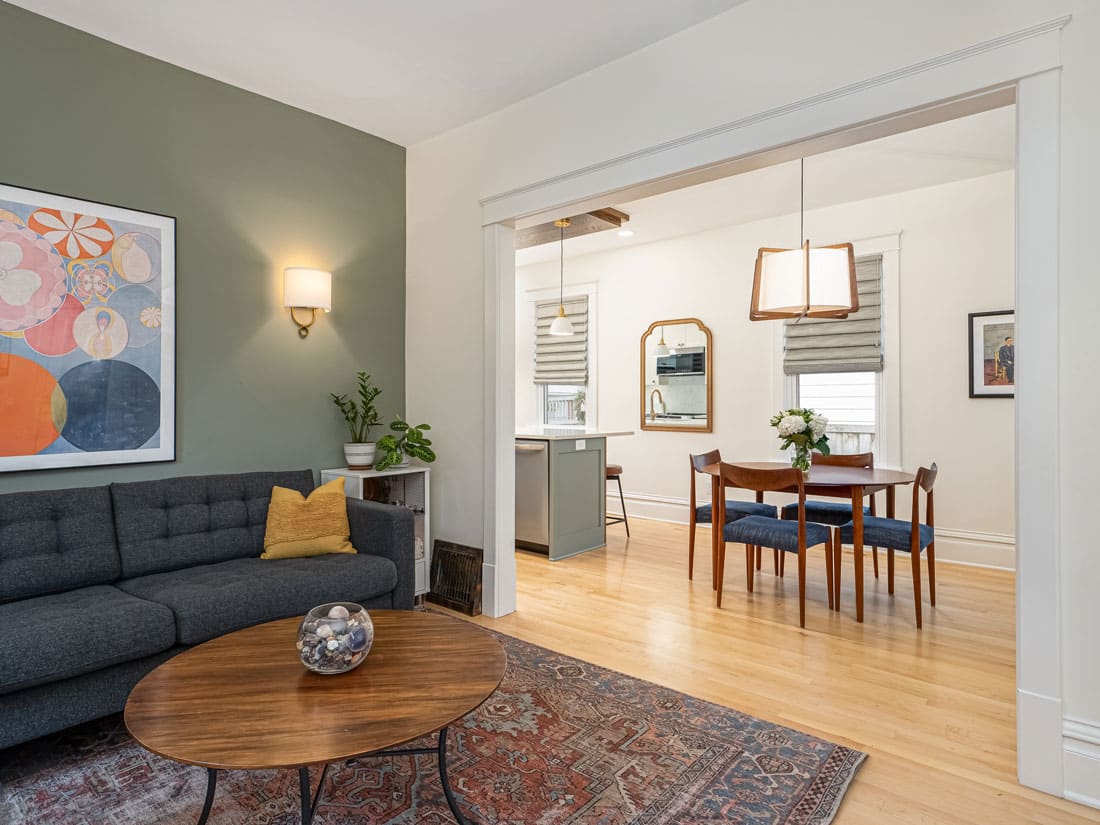
Real talk about a real remodel
After a year of living in their new space, Kate sat down with us to talk about their remodel. Here’s what she had to say.
What did you think when you saw the designs White Crane created?
“Anne and I were floored. It was remarkable to see our hopes actually on screen. It just cemented our decision. We were like, ‘Wow, what a cool way to be together in our home.’ From that moment, we realized, ‘Ohh, White Crane does this differently.’”
“From that moment, we realized, ‘Ohh, White Crane does this differently.”
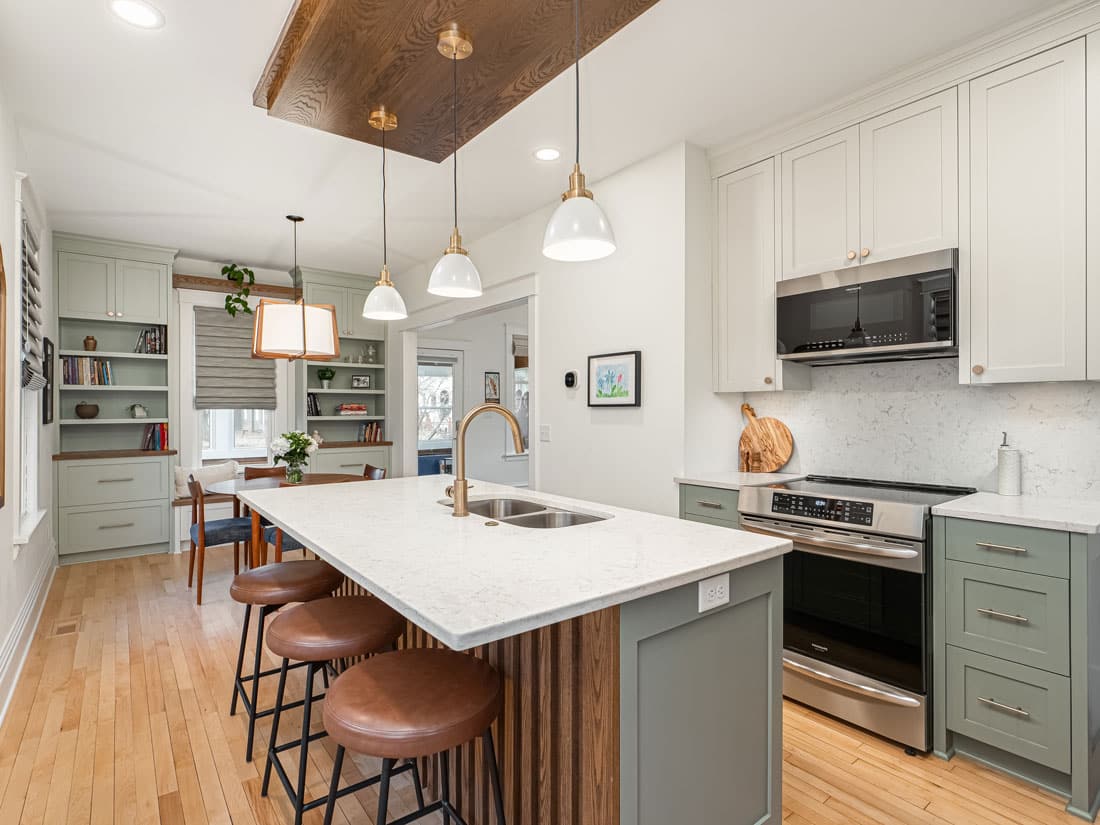
Besides having more space to be together as a family, what are some things you asked for?
“One thing we wanted was to feel more connected to the outside. We love being outside, so we wanted some greens, and some wood, and some different textures so it just helps us feel like we’re still there. Now there’s green, there’s wood. It just feels lovely. I also wanted a mini home office space, and they helped me figure out how to put that in the kitchen, with some big rollout shelves. It’s great.”
Is there anything White Crane suggested that you wouldn’t have thought of yourself?
“Yeah, like three-fourths of the project! I mean, their ideas were just revolutionary—although I think a lot of it was things they’d consider standard that were just a really big deal to us, like the type of lighting they suggested. We can see so much more in our house now. We used to have a lot of lamps and now we have multiple types of lighting coming from our ceilings.”
“White Crane also had some really great ideas about how to match the woodwork in our home. They had to kind of recreate it in some places—they had to build it and mill it. And now it all matches, and it’s so beautiful.”
“Even just recommending quartz for the countertops—I mean, all of it. It was just all remarkable.”
“Anne and I were floored by the design. It was remarkable to see our hopes actually on screen.”
Did they talk you out of any of your ideas? (And are you glad they did?)
“Yes! Our floors. We had two kinds of wood in our home—the front of the house had fir floors, and the back had oak. Initially, we were going to put fir everywhere, but the White Crane team very gently said, ‘You don’t want fir floors.’”
“They told us why—it scratches and dents easily—and then they said, ‘You know, if we put in oak, it won’t match initially, but as it ages, it will all become the same color, in like a decade.’”
“I’m so glad they suggested that because it’s so much lighter and brighter. It’s really beautiful.”
Now that you’ve lived in the space for a while, is there anything about it you weren’t expecting?
“Getting around our house feels easier. And even though the ceiling height didn’t change at all, it feels so much bigger. Overall, our small home feels so much bigger.”
Tell us about the process of the remodel. How did that go?
“Nothing seemed to surprise White Crane. Everyone else we’d talked to had sort of said, ‘Oh, well, this can go wrong, and hopefully this wouldn’t slow it down,’ but White Crane would literally say to us, ‘If you want a new window here, it will be three more weeks, and if you don’t, we have all of the materials to get started.’ It was all up to us and it just felt so transparent and clear.”

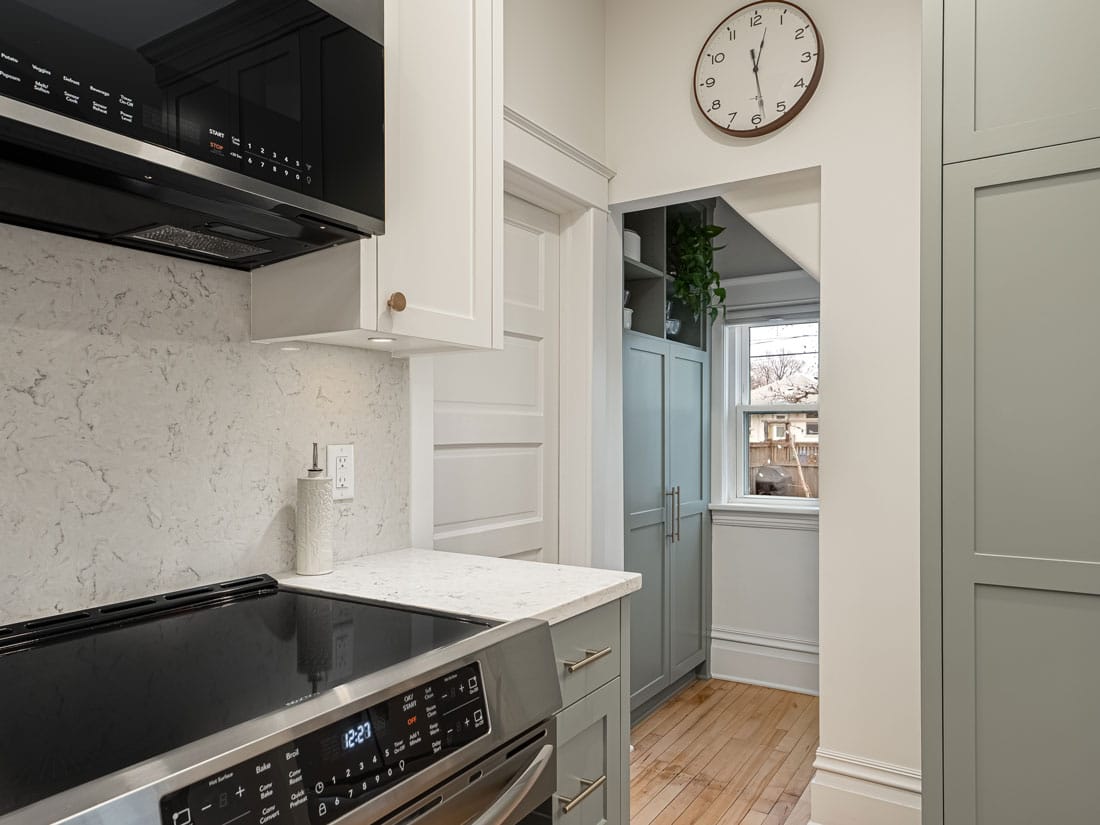
“It was all up to us and it just felt so transparent and clear.”
How did the day-to-day experience go during the construction phase?
“There was a lot of professional hand-holding along the way. We were given specific dates of how the project would go. And anytime I had a question, they would meet me at the house and show me what was going on. They also met with us every Wednesday morning. We got to walk through and we were told what was happening and what was on schedule and what wasn’t. It was really great.”
“I think the only thing we’d change is to just have White Crane do more things on our home.”
Is there anything you would have done differently?
“I think we just would have done more parts of our home. In the first design White Crane offered us, they built a mudroom off the back of our house, and it was almost an additional $100,000. And, at the time, we were like, ‘Oh, no. We didn’t save for that. That wasn’t part of the plan.’ But now that we’re in this beautiful space, I mean, if we’d just kind of planned for that mudroom, then our coats wouldn’t be in our kitchen.”
Have there been any other life-changing parts of the remodel?
“We finally have a dishwasher! I don’t know how we did it without one. We raised a baby! We had to boil bottles! It was like 1952 up in here. Having a dishwasher has been revolutionary. Our kiddo can help with the dishes, we can get them done right after dinner… It’s just a different way to be and we don’t take it for granted for one second.”
“Having a woman-owned firm was really exciting.”
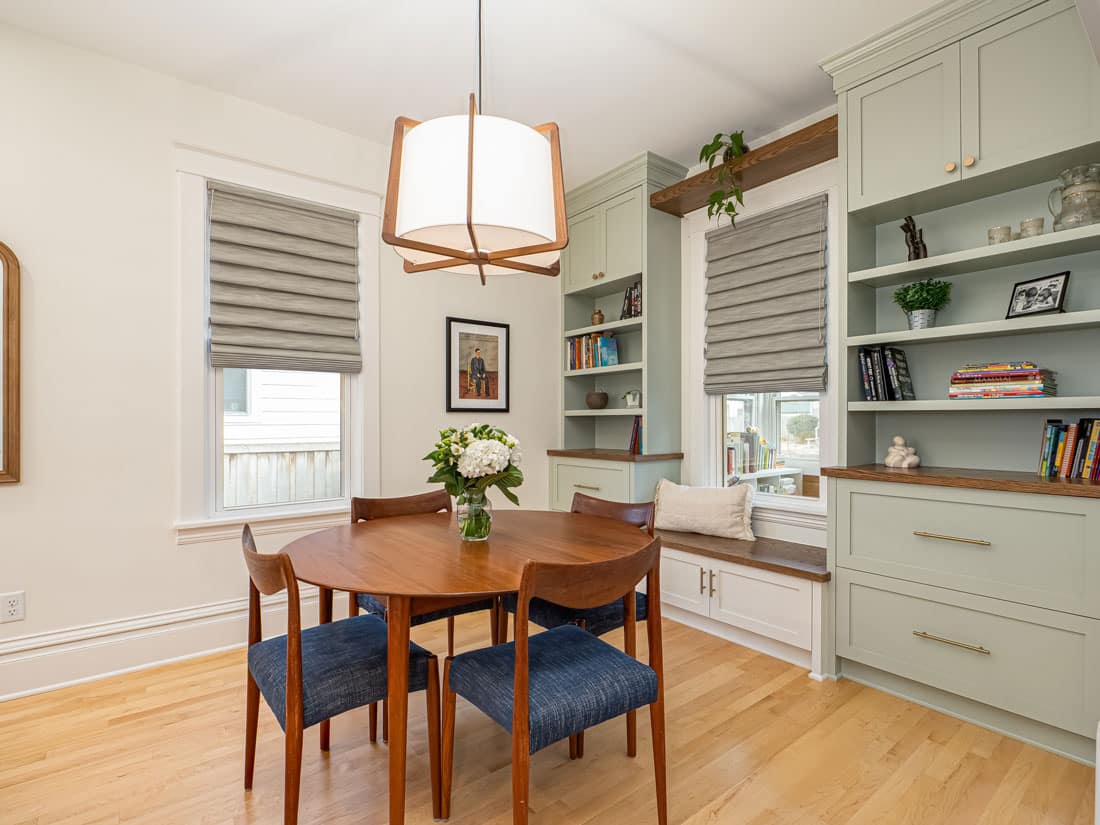
Why did you choose to work with White Crane?
“We had met with a couple of different people. They had good ideas, but no one was as professional as White Crane. No one came in and looked around and said, ‘What do you want?’ No one else said to us, ‘This is our specialty—making small Minneapolis homes more livable. That’s our favorite thing to do, and we have really good tricks that we think could make this space really different for you.’”
“It was just super refreshing to find experts in our little world—because not everyone does that.”
“And, for Anne and I, both being women, having a woman-owned firm was really exciting. Our whole team was women, other than the craftsmen. In my brain, this had been sort of a male-dominated field, so to feel like we could do this project in conversational ways that make sense to me and the way we operate in the world was just a huge bonus.”
Do you have any tips for someone who’s considering a remodel?
“I would say it’s super useful to work with designers that know older homes, because they’re going to suggest things that seem outlandish. You’ll think, ‘Really? You can get all of that in here??’ And, they can! That was sort of priceless.”
“It’s super useful to work with designers that know older homes.”
“And having both the designer and the builders not be afraid of a 112-year-old house. They just say, ‘Yeah, oh, look at this. This is crumbling.’ Or, you know, they’re making sure the floorboards hold. Just all of that. That’s just their daily work, and it was so useful. And appreciated.”
“I guess the last thing I would say if I was giving advice to someone would be don’t be afraid to say the thing you want. Don’t be afraid to say exactly how you want it to look—because they can make it look like that. Which is kind of remarkable.”
“It’s just a different way to be and we don’t take it for granted for one second.”